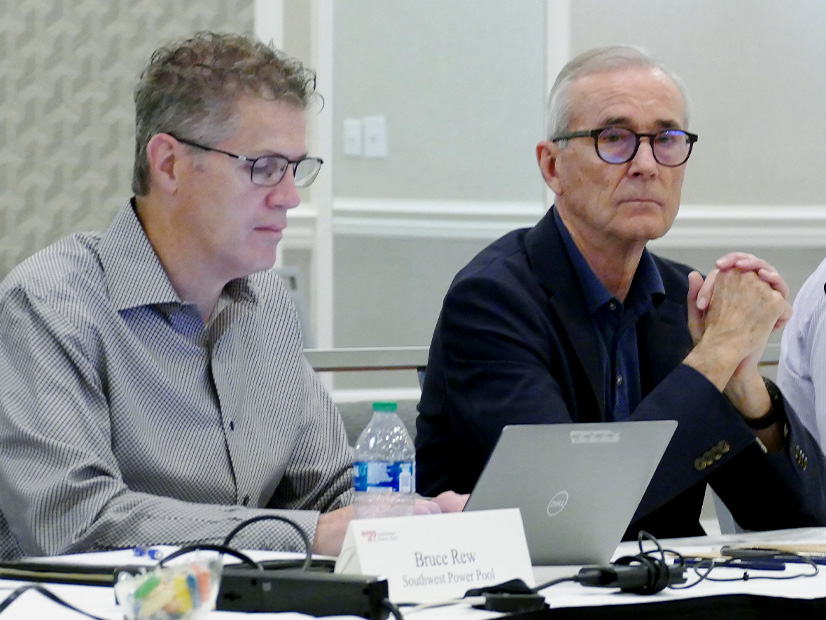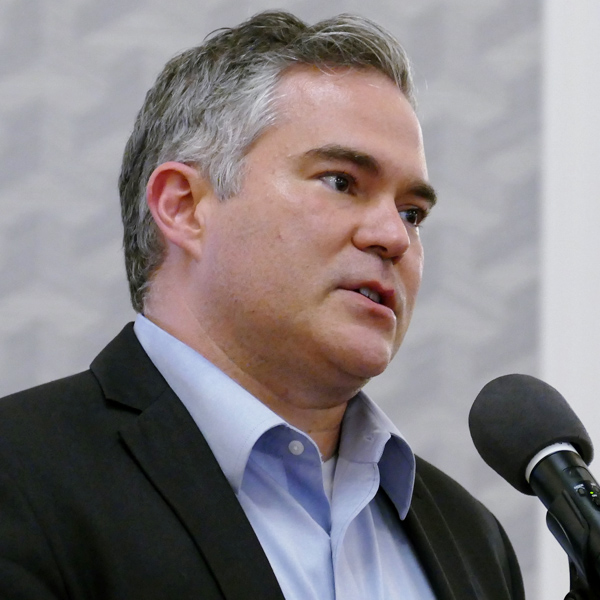
Staff Say Markets+ Design on Track for Completion in 2023
DALLAS — SPP staff last week said the RTO’s Markets+ day-ahead offering in the Western Interconnection is on track to be completed by the end of the year.
Bruce Rew, SPP senior vice president of operations, said the market’s development is going “really well,” with Western parties leading the three design teams (governance, market products and price formation, and transmission availability). Their first in-person meeting last month drew a capacity crowd, with almost the entire interconnection represented, he said.
A second in-person market-development meeting is scheduled June 1-2 at Tri-State Generation and Transmission Association’s headquarters in Westminster, Colo.
SPP last week told the Western Interstate Energy Board that it will eventually close its Western Energy Imbalance Service (WEIS) market after its seven current members join either the Markets+ program or its expanded RTO West. (See related story, SPP to Phase Out WEIS as New Market Offerings Expand.)
Obstacles remain, however. During Wednesday’s Strategic Planning Committee meeting, committee Chair and Director Mark Crisson brought up a panel discussion during the SPC’s retreat earlier this year. He noted participants anticipate CAISO, SPP’s competitor in offering RTO membership in the West, will correct its governance problems and pose a challenge for the RTO.
Other participants, while “generally supportive,” Crisson said, questioned whether SPP’s staff are spread too thin and that the membership is getting too big, potentially damaging the RTO’s stakeholder-driven culture.
Southwestern Public Service’s Bill Grant expressed his concern that some Western entities don’t want to give up their balancing authorities, which he said will create huge software costs.
“Now we have to curate a market model that has 34 different [balancing authorities],” he said. “It’s an EIS market on steroids, rather than a market with day-ahead dispatch. I believe it’s going to increase the cost for us to perform this service.”
Crisson, who spent nearly 30 years with Tacoma Public Utilities, said some entities may not understand the benefits of centralized dispatch and suggested it might be a “little bit of RTO paranoia” dating back to the 2001 energy crisis.
“There’s a lot of concern about FERC regulation,” Crisson said. “A lot of people remember that exercise.”
SPC Endorses Value of Tx Report
SPP’s updated value of transmission study has quantified $27.2 billion in net present value (NPV) of benefits over the next 40 years from $3.35 billion in members’ installed transmission from 2015 to 2019, staff said.
 Casey Cathey, SPP | © RTO Insider LLC
Casey Cathey, SPP | © RTO Insider LLC
The study’s 5.24:1 benefit-to-cost ratio is an increase from SPP’s first transmission-value study in 2016, which had a 3.5:1 ratio. That analysis found more than $16.6 billion in NPV of project benefits installed from 2012 to 2014. Casey Cathey, SPP’s director of system planning, said The Brattle Group called the first study “a path-breaking effort.”
The newer study refined the first one by analyzing five years of transmission projects instead of three, simulating 57 days of production instead of 38, excluding the benefits of reduced planning margins, and capturing the incremental capacity from transmission rebuilds and transformer upgrades.
“This is probably the most accurate study you can perform,” Cathey said.
The 2021 study does not quantify other benefits such as improved use of transmission corridors and storm hardening. The latter issue has gained importance with SPP following the first load sheds in the RTO’s 80-year history during the February 2021 winter storm.
“The value of resiliency is so critical, especially after this winter event,” COO Lanny Nickell said, “and it will be helpful to you all when customers are expressing doubts about the benefits of proposed upgrades. How much more load would have been shed had we not had that transmission?”
Members generally agreed, noting they’re now having those conversations about the transmission’s value.
“We got beat up in the commissions,” Oklahoma Gas & Electric’s Usha Turner said.
“I’m proud of what we’ve accomplished at SPP,” Grant said. “We’ve added all this transmission, and we’ve done it in such a way that the total bill to customers is below the rate of inflation. The total cost to customers has not dropped, but still, we’ve increased reliability and increased deliverability. That’s a win.”
The SPC also endorsed staff’s annual member value update, which indicates members enjoy $3.25 billion in annual savings and benefits and a 22:1 return on investment. SPP’s market operations account for the bulk of those savings, yielding $1.42 billion.
Staff used both quantitative and qualitative estimated values of various areas of the grid operator’s services to calculate the value provided to members through improved reliability, increased efficiencies and economics, consolidated functions, and improved environmental, public policy and local economic impacts.
A year ago, members were gaining $2.7 billion in savings and an 18:1 return on investment.
Mike Ross, senior vice president for external affairs and stakeholder relations, said the improved benefit metrics have primarily been driven by increased fuel costs and escalated LMPs. He warned the savings increase may only be a blip.
“We tried to err on the side of being cautious,” Ross said.
SPP Lays out Comprehensive Roadmap
SPC members endorsed staff’s recommendation to develop a schedule and details for a comprehensive roadmap process that will be part of SPP’s broader effort to develop strategic services such as data-management solutions, re-engineered and streamlined stakeholder processes, and defining tracking and reporting on metrics.
Board approval later this month will allow staff to move forward with instituting the process and balancing ongoing work against the approved schedule.
Staff told the Markets and Operations Policy Committee that the roadmap is intended to show stakeholders everything that’s on the RTO’s plate and to solicit their help with prioritizing the initiatives. MOPC declined to act on the roadmap over concerns of costs associated with staff and consultants.
“Resource management is a crucial element that we haven’t figured out,” Nickell said. “That is an issue, and we are very aware of the concerns around that.”
“This has been a heavy lift. I do worry about maintaining it,” American Electric Power’s Richard Ross said.
The comprehensive roadmap is intended to develop a “proactive, transparent and collaborative annual and ongoing process” that balances SPP’s portfolio of work and managing resource constraints. Staff hopes to identify the greatest needs for improvement over a five-year timeframe and create alignment with and direct input for initiatives into the RTO’s strategic planning, budgeting, and project management processes.
Ad Hoc Group to Look at Cryptos
The committee agreed to form an ad hoc group to determine how best to address flexible loads like data centers that generate Bitcoin and other cryptocurrencies and are popping up on electric grids all over the country.
Nickell cited the uncertainty around the size and nature of the loads in suggesting the SPC own the issue. Bitcoin miners say they can quickly shut down their operations should the energy be needed elsewhere or operate during off-peak hours.
“Do we really want to be funding transmission improvements for temporary loads?” Nickell asked, rhetorically. He suggested the ad hoc group focus on transmission issues and cost allocation, recognizing that the SPC may want to take a broader look.
The Regional State Committee (RSC), comprising state regulators with authority over regional transmission rates, is expected to eventually be involved.
“I don’t understand how the RSC can’t be involved in this. At the end of the day, this is regional load,” Grant said. “If we don’t come up with a concise way to deal with this or [the RSC] doesn’t agree with it, they’ll go to their individual commissions.”
“We saw a similar phenomenon in the Northwest 15 to 20 years ago with load centers,” Crisson said. “Most utilities took the same approach, requiring them to pay for any substation and transmission upgrades, which cooled their enthusiasm considerably.”
The group will report back to the SPC during the committee’s July meeting.

